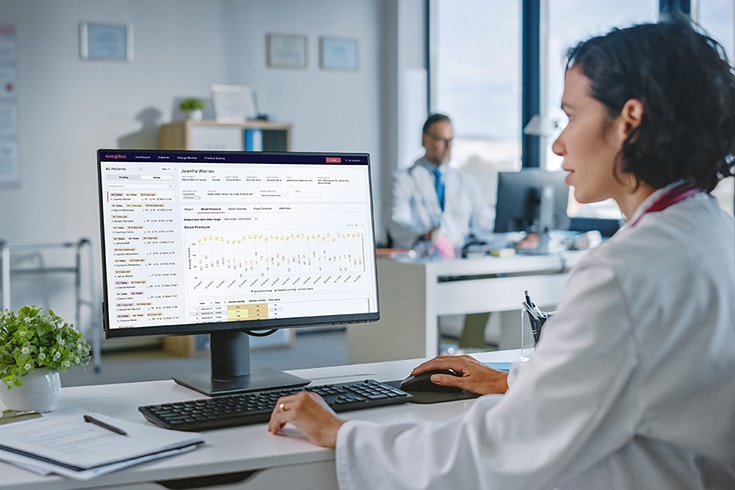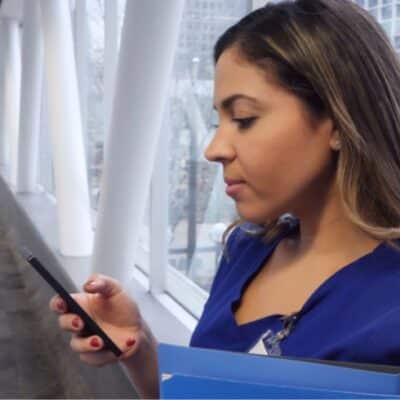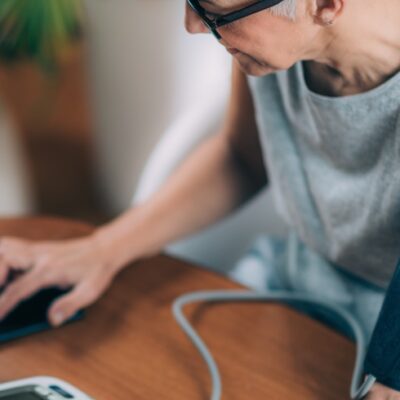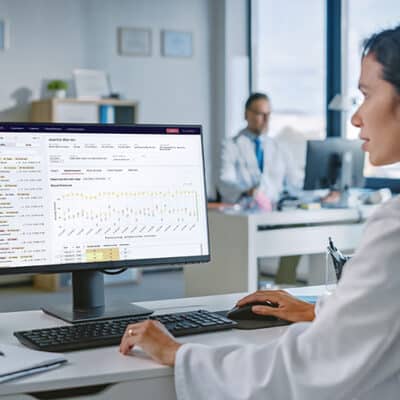What is Remote Patient Monitoring?
Remote patient monitoring (RPM) is the best way to continuously track patients’ health and bring additional revenue to practices. RPM works to manage current chronic conditions. From blood pressure to blood glucose, patients have seen incredible results while measuring their biometrics from the comfort and safety of their home.
Practitioners not only benefit financially from remote patient monitoring programs, but are also able to track their patients between sporadic doctors office visits. With additional data, practitioners can make more informed decisions when it comes to treatment and medication. Managing chronic illnesses has never been so easy — learn how RPM can benefit your practice and your patients today.
Remote patient monitoring bridges the gap of effective communication, trust, and support between medical providers and Medicare patients. By definition, RPM is a program in which healthcare providers receive and review data from remote patients through connected medical devices. This data is collected and securely transmitted from devices directly to providers. This process mitigates time and resource constraints on providers while relieving the stress of travel and doctor visits on patients. As a subset of telehealth, RPM is a rapidly evolving program whose growth is encouraged and sustained by platforms like 100Plus. Let’s talk about how this evolution can benefit your patients and benefit you as a medical provider:
Benefits of Remote Patient Monitoring
Patient Benefits of Remote Patient Monitoring
For your patients, Remote Patient Monitoring is a life uninterrupted by appointments, exhaustive travel, phone calls, and confusing patient portal systems. With access to free, easy-to-use medical devices that automatically transmit data to providers, patients can be monitored on a daily basis; making it possible for medical providers to identify potential risk and illness proactively. This proactive approach helps to prevent emergency room visits, readmissions, and can even work to extend patients’ time at home rather than placing them in nursing facilities. With no cost, easy access to devices, and no manual data entry, patients are granted support and individuality from the comfort of their homes.
Medical Provider Benefits of Remote Patient Monitoring
For medical providers, RPM provides a constant and sustainable stream of revenue. Companies such as 100Plus are making it even easier for RPM to sustain smaller clinicians with additional revenue by providing a model that eliminates upfront costs. A monthly service fee in lieu of initial outlay allows providers to utilize the RPM technology immediately without upfront payment.
Why Start Remote Patient Monitoring Now?
By utilizing RPM, medical providers can bridge the gap between clinicians and patients, no matter the distance between them. With RPM, Clinicians and patients alike are given the opportunity to build a foundation of effective communication, trust, and support from the comfort of their respective homes. Remote Patient Monitoring (RPM) represents the future of accessible and affordable healthcare for senior patients.
What Does a Comprehensive Remote Patient Monitoring Program Include?
When looking for the right Remote Patient Monitoring program for your practice and your patients, it can be difficult to choose. While many companies offer RPM programs, it’s important to know what makes one program a better fit over another. A comprehensive RPM offering should include all of the following:
No upfront costs
RPM programs should offer free sample devices for practices and no cost devices for patients; allowing practices to test drive their product without requiring a credit card or alternative cost.
White Glove setup
White Glove setup consists of patient outreach, education, and enrollment. RPM programs should automatically identify eligible patients within your practice who would benefit from the use of remote monitoring devices. Once identified, your program should also obtain patient consent, send fully configured and functioning RPM devices directly to the patient, and train them on their devices best practices.
Rapid scaling
An RPM program’s ability to scale your patients is essential when it comes to expanding your practice and revenue. Onboarding your entire patient population in a matter of days may be crucial for patients who require immediate remote monitoring.
Medicare eligibility checks
Even if a majority of a practice’s patient population fall under the umbrella of Medicare, they may not all be eligible for Remote Patient Monitoring. Your ideal program should check your patient population for you and only contact those that are willing and able to participate in the RPM program.
AI assistance
The future of healthcare lies in the hands of artificial intelligence. Though AI assistance is not offered by the majority of RPM programs, it is necessary when it comes to giving your patients the best care possible and running your practice efficiently. AI virtual medical assistants handle scheduling, coaching, and daily patient reminders so that practitioners can focus solely on caring for their patients.
Predictive Population Health Management (PHM)
Population Health Management (PHM) is critical in the process of monitoring remote patients. When patients record measurements that fall outside of a safe range, medical staff is notified.
No cost, ready to use, integrated cellular devices
With the right RPM program, remote monitoring devices should come at no cost to the patient or practitioner. They should also be ready to use upon arrival and be equipped with integrated cellular capabilities so that patient data can be transmitted to practitioners safely and quickly without the need to plug any device in or manually enter data into a patient portal.
Automatic transmission of data without user intervention
Recording patient data at home should require no user intervention. The proper RPM program should supply your patient population with devices that automatically transmit data to their providers so that practitioners can stay informed and patients can focus on measuring their biometrics.
Why Remote Patient Monitoring Should be an Essential Part of Telemedicine
RPM provides the longitudinal patient health data in real-time that is needed for the care management of patients with chronic conditions.
What is telemedicine?
Telemedicine encompasses two-way, real-time communication between patients and healthcare providers, including phone conversations, video, and chat. There are various telemedicine software and technology that make electronic consultations, real-time interactions between providers and patients. With recent technological innovation in the telemedicine industry, many healthcare providers are starting to adopt videoconferencing for care management, diagnosis, counseling, and monitoring of patients.
What role does RPM play in telemedicine care?
While telemedicine eliminates the barriers of transportation and distance, telemedicine on its own just covers a virtual conversation between a healthcare expert and patient about past health data and described symptoms. RPM data and population health alerts on the other hand provide real-time information about when at-risk patients’ results are out of a defined range to allow practitioners to rapidly intervene and the facts necessary to have an informed patient appointment.
To fully utilize telemedicine consultation, physicians need data about their patients’ conditions to understand who needs to be attended to and who needs intervention. Remote Patient Monitoring provides that missing data to better inform providers to provide optimal care for their patients. The real-time patient data informs a telemedicine visit and assists healthcare providers in ensuring a patient is in compliance – all without an office visit.
Remote Patient Monitoring Solutions Providers
Remote Patient Monitoring has become more sophisticated in recent years. Technology and devices being used are more innovative than they used to be. For example, 100Plus offers a comprehensive RPM solution that enables providers to receive patient health data as a fully automated charting experience and automated patient health alerts whenever the patient’s data is out of the normal range. They send the monitoring hardware directly to the patients all set up with cellular capability so patients just have to use the device. Then the data automatically uploads to the provider chart area in the web-based online provider portal. Providers will have access to their provider portal online anytime. 100Plus also sends automatic population health alerts to the providers whenever their patient data is out of the normal range so the providers can check their patient data history and provide the care to avoid costly ER visits. Patients use RPM devices at home or on the go to share health information like blood pressure, weight, and temperature with their healthcare provider. With an RPM platform such as 100Plus, healthcare providers can reduce episodic care and improve patient care by continuously monitoring high-risk seniors in your population.
Remote Patient Monitoring enables providers to serve their patients with chronic conditions such as diabetes, obesity, and congestive heart failure via cellular-connected devices and receive longitudinal data in perpetuity. The output informs a telemedicine visit and assists healthcare providers in ensuring a patient is in compliance – all without an office visit.
Remote Patient Monitoring also alerts providers when patients are out of compliance, enabling a provider to intervene with the goal of avoiding expensive, episodic care – all without an office visit and thus alleviating stress on the health system.
Telemedicine on its own solves part of the problem, but remote patient monitoring ensures that practitioners are not flying blind during telemedicine visits. Doctors and other healthcare providers can now have access to real-time patient data to inform their decisions, making virtual care a true reality for seniors at home.
Most seniors suffer at least one chronic condition, have limited financial resources, and significant technology barriers, making it difficult for them to get care when they need it. Providing care to this population, by monitoring and treating their chronic conditions, is critical for their health and our healthcare system. If their conditions, such as diabetes, obesity, and congestive heart failure, become unmanaged, it can result in potentially catastrophic and expensive outcomes, further stressing the healthcare system.
Addressing a growing need to serve seniors at home, virtual care, including telemedicine and remote patient monitoring, has come to the forefront as an effective method of managing chronic conditions of seniors and improving outcomes.
The Economics of Remote Patient Monitoring for Your Practice
The Centers for Medicare and Medicaid Services (CMS) has taken steps to make it easier for practices to provide this type of care to their patients by introducing new CPT codes and removing barriers to entry. Among these are the Remote Physiologic Monitoring CPT codes for care services that help improve outcomes of Medicare patients with chronic conditions while providing additional revenue streams for medical practices.
In 2019, Medicare introduced reimbursement for RPM, often making it no cost to seniors with at least one chronic condition. Even during “normal times,” going to a medical office or clinic for seniors has been logistically challenging, as approximately half have transportation barriers to get to their doctor.
In addition to these pandemic driven CMS decisions, they have made other recent notable decisions. The two most hotly anticipated changes for providers include:
- The decision to allow RPM to be furnished “incident to” under general supervision.
- The addition of CPT Code 99458: a new add-on code for patients who receive an additional 20 minutes of RPM services in a given month (i.e., 40 minutes of RPM service, rather than the previously allowed 20 minutes).
These changes have expanded how healthcare providers can treat their patients using RPM. They can now treat their chronic care patients not only using traditional CCM codes, but they can provide a wider array of care options with RPM and spend more time on that care with the addition of CPT 99458. CMS also expanded who is empowered to provide RPM care to patients, enabling practice nurses and staff to take on the process of monitoring patients’ data and escalating that information if a patient’s health information indicates a need for intervention.
Typically, physicians are the highest-paid employees in a practice, so enabling other staff members to perform RPM tasks increases the return on investment in the program and frees doctors to focus on making the best healthcare decisions for their patients.
Access the Latest RPM News
Stay up to date with the latest news, articles and webinars about remote patient monitoring and telehealth.
"*" indicates required fields



